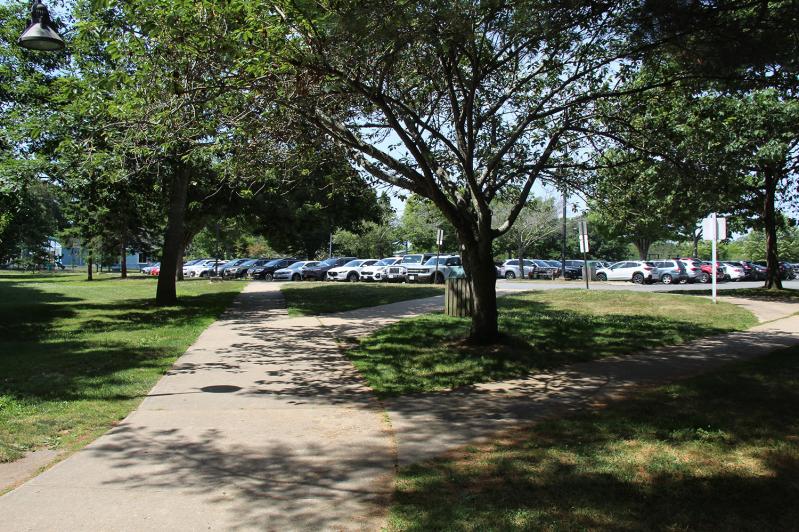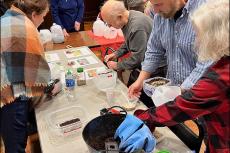East Hampton Village has settled on a preferred location for a new underground wastewater treatment facility — under the long-term parking lot off Gingerbread Lane — but it could be years from completion, a consultant told the village board last week.
At the board’s meeting on July 6, Mayor Jerry Larsen expressed frustration at the time it is taking for the New York State Department of Environmental Conservation to issue approvals for the sewer system.
“This underground plan is great,” said Mayor Jerry Larsen, who is also chairman of the village’s central sewer committee. “The only issue is the state has never granted a permit for this in its history. Yet. We’re just waiting for the state to make a decision,” he said. The village had expected approval to come last December.
“At the end of the day, something like this is easy four years from where we are today. But plan on five,” said Pio Lombardo of Lombardo Associates, an environmental engineering and consulting firm working with the village.
The D.E.C., in an email, said it sent the village “a notice of incomplete application on May 17, 2022, for additional information for the development of a new municipal sewer district/sewage treatment plant. The review will continue upon receipt of the requested information.” The notice, written by Elyssa Scott, an environmental analyst, included 20 points needing clarification from the village.
The $24 million system would treat a minimum of 75,000 gallons of wastewater, which is about how much the village now generates, according to Mr. Lombardo. Marcos Baladron, the village administrator, in an email, said the village hoped to pay the entire amount through a mixture of state grants and community preservation fund money.
According to State Assemblyman Fred W. Thiele Jr., whose district includes the Village of East Hampton, getting C.P.F. money for the sewage treatment is “far from a done deal.” Over text, he said that the “use of the C.P.F. for water quality projects is limited to 20 percent of annual revenues” for the municipality. He is seeking to increase the percentage, and it will be discussed with the East End Supervisor and Mayors Association. However, he cautioned, “any such change would require state and town legislation and a townwide referendum.”
Mr. Lombardo described his proposal: Septic tanks would remain, and their wastewater would be collected by a septic tank effluent system. Two pump stations, one in front of the post office, and another in the Reutershan parking lot behind Main Street and Newtown Lane, would move the wastewater to the treatment site. Only the liquid waste would be transported to, and treated by, the “water resource recovery facility.” The reclaimed and treated water would then be used for “subsurface irrigation” at Herrick Park.
Access to the facility would be via manholes placed along the median strips of the long-term lot.
“The only thing that’s visible is the operations building,” said Mr. Lombardo, which he said would be just over 600 square feet. It would contain electrical equipment and lab facilities so operators could test the water.
Mr. Lombardo said the facility would treat “forever chemicals,” so called because of their inability to break down in the natural environment, and other contaminants, including pharmaceuticals and personal care products. Ultimately, the treated water would contain under two milligrams per liter of nitrogen, “the best in the industry,” he said.
The Eleanor Whitman Early Childhood Center and the John M. Marshall Elementary School fields are adjacent to the lot. “There are always questions about odor and noise,” said Mr. Lombardo. He said most everything would be below ground, except for one fan “housed in a sound attenuating unit” and that there was a “very aggressive odor control system,” which would prevent odors from escaping.
He engineered a similar system in Malibu, Calif., 15 years ago, and “never had an odor complaint from fancy restaurants.”
Mayor Larsen gave a brief history of how the village determined that the long-term lot was the best place for the facility. He said that when he entered office, the village and its consultants, Nelson Pope Voorhis, were already studying options for adding sewers to serve the downtown. But they “weren’t getting anywhere,” Mr. Larsen said. So, in September, he reached out to Mr. Lombardo, who, according to the mayor, had originally suggested that the village add sewers in 2013.
Mr. Lombardo came up with the “underground plan” last fall, but since D.E.C. approval wasn’t immediate (“For municipalities, the D.E.C. is the sole permitting agency,” he said), the village, with $115,000 in grant money secured by Dominique Cummings, the village treasurer, sent him out to explore other options.
“The unofficial feedback was that the town would not approve of any treatment system through the town property,” so they had to stick to village land, the mayor said.
The only other location that had potential was previously identified by Nelson Pope Voorhis: the village’s Highway Department building, at 172 Accabonac Road. Last April, before Lombardo Associates was hired, they put forth a plan that would have treated 60,000 gallons per day at that site and was estimated to cost $12.5 million, roughly half that of the parking lot plan. While that site is in the town, it is owned by the village. However, to place the wastewater treatment plant there would require a potentially lengthy site plan approval from the town planning board that Mayor Larsen said he would rather avoid.
“The parking lot would be a lot simpler because all permissions would come through the village,” he said.
In the meantime, the D.E.C. came back not with an approval, but with their aforementioned request for more information. “They need more detail because of their lack of familiarity on what’s being proposed,” said Mr. Lombardo.
Carrie Doyle, who was sworn in as a new village trustee earlier in the meeting, asked if Mr. Lombardo was able to answer the D.E.C.’s questions.
“They want a lot of engineering work done,” he said, which went beyond the scope of his original agreement with the village.
He said a similar system was in use in Hampton Bays. The facility in East Hampton would use the same technology, he said, it would just be larger. “It’s all modular,” he said. “We tried that position with them, but they want more information,” he said.
Mayor Larsen gave the board a choice. It could either abandon the underground idea and get started with the Accabonac Road site or use the rest of the grant money (a little less than half was paid to Lombardo Associates to come up with alternative plans if the parking lot falls through) to pay Mr. Lombardo to get the extra information that the D.E.C requires. In the meantime, to help inform their decision, board members would make a field trip to Hampton Bays to tour that system.
An informal vote indicated that the board wanted to pay Lombardo Associates and hope for D.E.C. approval for the parking lot idea. A formal vote, after the Hampton Bays field trip, is expected at the July 29 meeting.




